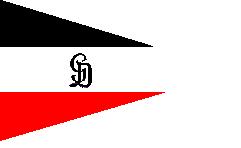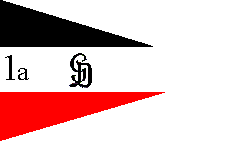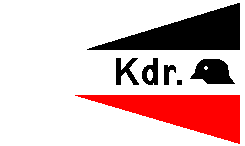Units of battalion, regiment or brigade size were designated by
a flag bearing the Waffenfarbe, or arm of service colour, associated with that unit.
Grossdeutschland's command vehicles would thus have been marked by a unit pennant in
white. Upon expansion to divisional status, GD panzer battalions would have used
rosa (pink), artillery red, signals lemon yellow, pioneers black, reconnaissance golden
yellow, and the infantry (later panzergrenadier and panzerfüsilier) regiments retained
white.
| Panzer Groups During the invasion of France, two formations named for their commanders,
Panzer Group von Kleist and Panzer Group Guderian, wore capital letters denoting these
designations on their vehicles as an additional form of identification. After the
invasion of Russia, other formations sometimes wore similar unofficial markings- GD wore
the "G" on their vehicles during the early phases of the invasion of Russia,
while attached to Panzergruppe 2. |
G |
K |
Vehicle Numbers
| The early Panzertruppe GD (also known as Panzer Abteilung
GD) consisted of a battalion-sized group of armour with 3 companies. The 1st
company, equipped with PzKpfw IVs, used their own system of markings for at least a short
time. |
 |
In general, however, the system involved use
of 3 digits numbers; the first digit indicating the Company the tank belonged to, the
second the Platoon, and the third the vehicle's position within the platoon.
The 13th company of Panzertruppe GD (and from the summer of
1943 on, the entire III Battalion of the Panzer Regiment) was equipped with Tiger tanks,
and they numbered their vehicles with the letter S (presumably for "schwere", or
heavy) followed by a two digit sequence representing the platoon and vehicle. After
the Panzer Abteilung expanded to a full regiment, and an entire battalion of Tigers was
created, the unit used the letters A, B and C to indicate the 9th, 10th and 11th companies
of the Panzer Regiment GD, again followed by a two digit sequence representing platoon and
vehicle.
| An interesting variation confirmed by
photographic evidence was the use of the GD steel helmet replacing the R on the command
tank of the commander of Panzer Regiment Grossdeutschland. The helmet was very small
so as not to be obtrusive, and used in conjunction with the numerals 01. |
 |
Unofficial Unit Markings
| Some GD vehicles are seen with a windmill device painted on
the side, a reference to a familiar landmark near Stonne in France where GD fought its
first large scale battle in 1940. According to one source these windmill
emblems appeared only on motorcycles, Sd Kfz 250 halftracks and troop carrying vehicles -
and apparently only during maneuvers in early 1942. This
marking also reappears in 1944, known as the "uhu" or owl marking, and is
believed to have been used only by the reconaissance battalion. |
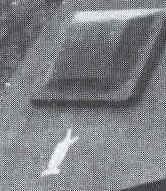 |
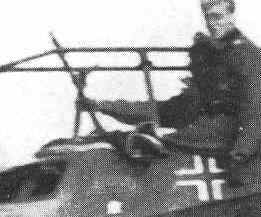 |
| One reference (an article by a
Mr. Kitamura's in Panzerblatt #6 (Armour Modelling magazine, issue 6) says
that the reconnaissance battalion had their armoured cars carry this marking because of
the commander's name (Usedom) and Hussar tradition (Usedom Husaren). The first
letters of Usedom and Husaren are, of course "Uhu", which in German means
"owl" - a creature associated with wisdom or intelligence. |
The First (armoured) Battalion of the
Panzerfüsilier Regiment was nicknamed the "Lion Battalion", after their
commanding officer Horst Niemack continuously referred to them as "killer lions"
in action. On 20 August 1944, he promulgated the following order:
I Battalion has fought extremely well in the battles of
the past few days.
In recognition of its proud success, with the authorization of the division
commander I decree that the battalion may apply the lion to its APCs as a special
recognition marking. Niemack.
| Unknown Markings And finally, some markings for which photographic evidence is in
existence may never be fully understood. The following photo shows Maultier
halftracks of a GD supply column, taken in 1943. Two digit numbers are worn on the
doors of the vehicles, with the GD steel helmet and tac signs on the fenders. The
arrow symbol on the bonnet of the truck is a mystery.
 |
The tactical sign is the 1943 version of the "truck
column" sign. The M may stand for "mittlerer" for medium, or perhaps
"Maultier", the type of truck. The thick bar on the left indicated a
company sized unit. |
 |
The bottom part of the tactical sign - indicating the method
of transport - is obscured in this photo, but would indicate either a motorized unit
(above left) or half-tracked (left). |
|
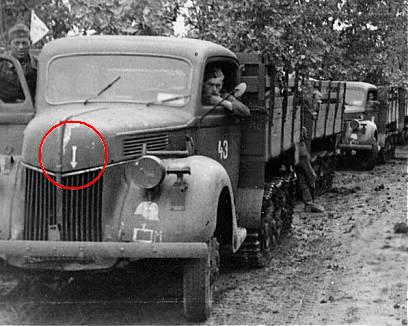
Photo courtesy Collection Akira Tamaguchi
|
|







